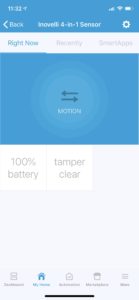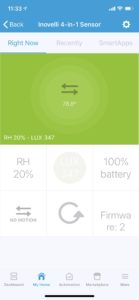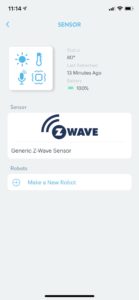Inovelli 4-in-1 Sensor Review
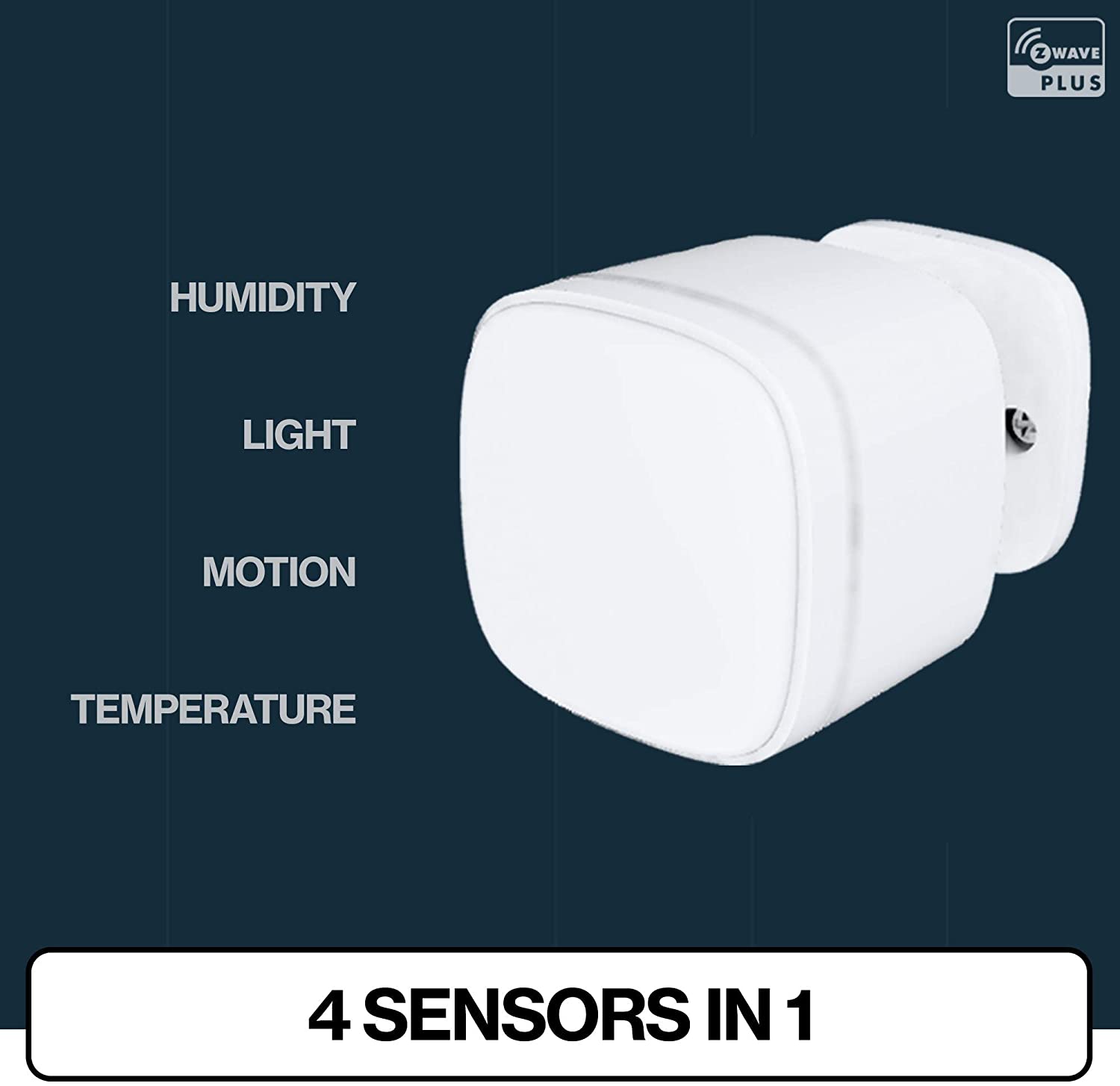
The Inovelli 4-in-1 Sensor model LZW60 is Inovelli’s first venture into the sensor world. I find the decision to go after the 4-in-1 market to be a good idea. The sensor offers Motion, Temperature, Humidity and Light detection. What else would you need? In true Inovelli form, this is a highly configurable device and requires a custom device handler to unlock the full capabilities on SmartThings and Hubitat. I performed tests on Wink and Vera as well.
Inovelli 4-in-1 Sensor on Amazon
Overall Rating 
I must admit that I have an affinity for Inovelli products and I really wished I could have given this little toy a 5-star review. But since my loyalty is to the consumer and not the brand, you’ll see why I just couldn’t bring myself to a 5-star on this one. Being their first venture into the motion market, they did a respectable job. Just not the home runs I’m accustomed to with the Inovelli line of products.
The first thing that hits you is the size. The two pictures compare the size of the Inovelli 4-in-1 Sensor (right) to the Aeotec MultiSensor 6 (left). Keep in mind that the Aeotec carries two CR123 batteries, while the Inovelli only has one What’s with all that extra space?
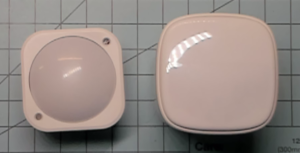
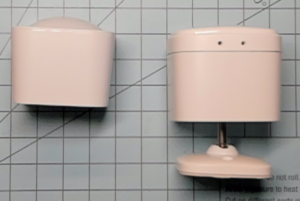
Motion Features 
Ticks all the boxes for motion, and then some. That is if you have the custom device handler for SmartThings and Hubitat. Not a complaint, just letting you know. My only wish on the motion side is that they could have made the detection range a bit further. My tests put this firmly at 15 feet (5 meters), at that was at maximum sensitivity.
| Feature | Specification |
| Detection Angle | Not published (that I could find) – My tests put it ~ 130 o |
| Detection Distance | Not published (that I could find) – My tests put it at ~ 15 ft (5 meters) with motion sensitivity set to 10 (high range) |
| Indoor / Outdoor Rating | Indoor Only |
Additional Features 
The other (light, humidity, and temperature) sensors are rock solid in my opinion. The temperature, humidity and light readings all seemed like numbers I could trust. The only thing this unit is missing is tamper detection. But then again, who uses this anyway? All readings were available in Vera, Hubitat and SmartThings, although you have to fiddle with Vera to get this to come in correctly. More on that later. When paired as a Generic Z-Wave Sensor in Wink, you get Temperature and Humidity, but no light, and no motion. This is a Wink issues as we’ve discussed on other multi-sensor reviews.
| Feature | Specification |
| Light / Lux | Yes |
| Temperature | Yes |
| Humidity | Yes |
| UV | No |
| Vibration / Tamper | No |
Hub Compatibility 
This multi-sensor is best suited (as a full 4-in-1) for Hubitat, SmartThings and Vera (maybe others that I didn’t test). If you are planning on using a different hub, there are considerations. Please read the notes below carefully. I would also advise checking with Inovelli as their information will be more up to date than my website. It appears that the Wink issues are more hub-related than sensor related, since the Aeotec MultiSensor 6 and the Zooz 4-in-1 have the same problems in Wink and Vera.
As a general note – whenever I have trouble getting something to work, trust me when I tell you I don’t give up easily. And in the end, it only means that I couldn’t get it to work. It doesn’t mean that the device itself had a problem. The problem could always be me.
| Hubitat | SmartThings | Wink Hub | Vera | |
| Compatible | Yes | Yes | Motion & Light = No
Temp & Humidity = Yes See the Hub Specific notes below the table. |
Motion, Temp, Light, Humidity = Yes
See my instructions below for pairing this into Vera. |
| Custom Driver Required | Yes – I could not get this to work with the Generic Motion / Temperature Driver in Hubitat. Custom Driver only. | No – Use the built in driver “Z-Wave Motion/Temp/Light Sensor” for local control.
For advanced features use the following: SmartThings Custom Device Drivers |
N/A | No, but some tweaking of the Vera settings is required (see Vera Specific section below the table). |
| Preferences (below) | ||||
| Motion Re-trigger Interval | 5 seconds to 15300 seconds (255 minutes or 4.25 hours) | 5 seconds to 15300 seconds (255 minutes or 4.25 hours) | 30 seconds | 5 seconds to 15300 seconds (255 minutes or 4.25 hours) |
| Motion Sensitivity | 0 (disabled) to 10 (high range) | 0 (disabled) to 10 (high range) | 8 | 0 (disabled) to 10 (high range) |
| LED Indicator Mode | Not adjustable | Not adjustable | Not adjustable | Not adjustable |
| Temperature Change Trigger | 1 – 500 (tenths of degrees I assume) | 1 – 500 (tenths of degrees I assume) | 10 | 1 – 500 (tenths of degrees I assume) |
| Temperature Offset | -10 to +10 | -10 to +10 | 0 | -10 to +10 |
| Temperature Reporting Interval | 0 (disabled) to 2678400 seconds (44,600 mins or 743 hours or 31 days) | 0 (disabled) to 2678400 seconds (44,600 mins or 743 hours or 31 days) | 7200 | 0 (disabled) to 2678400 seconds (44,600 mins or 743 hours or 31 days) |
| Humidity Change Trigger | 1% to 32% | 1% to 32% | 5% | 1% to 32% |
| Humidity Offset | -10 to +10 | -10 to +10 | 0 | -10 to +10 |
| Humidity Reporting Interval | 0 (disabled) to 2678400 seconds (44,600 mins or 743 hours or 31 days) | 0 (disabled) to 2678400 seconds (44,600 mins or 743 hours or 31 days) | 7200 | 0 (disabled) to 2678400 seconds (44,600 mins or 743 hours or 31 days) |
| Luminance Change Trigger | 1 to 65528 LUX | 1 to 65528 LUX | 150 | 1 to 65528 LUX |
| Luminance Offset | -100 to +100 | -100 to +100 | 0 | -100 to +100 |
| Luminance Reporting Interval | 0 (disabled) to 2678400 seconds (44,600 mins or 743 hours or 31 days) | 0 (disabled) to 2678400 seconds (44,600 mins or 743 hours or 31 days) | 7200 | 0 (disabled) to 2678400 seconds (44,600 mins or 743 hours or 31 days) |
| Low Battery Alert Level | 10%-50% | 10%-50% | 10% | 10%-50% |
| Batter Reporting Trigger | 1% to 100% | 1% to 100% | 10% | 1% to 100% |
| Battery Reporting Interval | 0 (disabled) to 2678400 seconds (44,600 mins or 743 hours or 31 days) | 0 (disabled) to 2678400 seconds (44,600 mins or 743 hours or 31 days) | 7200 | 0 (disabled) to 2678400 seconds (44,600 mins or 743 hours or 31 days) |
Hubitat Notes 
This is pretty straight forward. Get the Custom Device Driver installed. Pair the device. Set the parameters and you’re off and running. I could not get this to work in Hubitat with the Generic Drivers like I could in SmartThings.
SmartThings Notes 
This is a very capable sensor inside SmartThings with the proper device handler. I found the performance to be a little sluggish, but that could be due to the custom driver being loaded in the cloud. See the Overall Performance section below for the test results.
When I brought this into SmartThings without the custom device handler, it showed up as a Generic Motion Sensor as shown below. The only options available were to rename. With no changes to the device handler, this is a motion only sensor and you won’t get the 4-in-1 capabilities.
I went into my SmartThings Account (from the PC) and changed the device driver to SmartThings in-built generic Z-Wave Motion/Temp/Light. With the generic multi-purpose driver installed, I was able to access 3 of the sensors (motion, temp and light), but no humidity. As for settings, again, you can only change the name of the device.
To get full power of the device in SmartThings, you will need to use the Inovelli custom device handler. It’s well worth the trouble. It will provide access to all capabilities of the sensor and all of the cool setting listed in the above table.
Wink Notes 
I never could get this to pair as a motion sensor or light sensor. However, temperature and humidity performed fine. You need to bring this is as a Generic Z-Wave Sensor when pairing. It will ask you which kind of door sensor. This is a Wink failing in my opinion, not an Inovelli LZW60 problem. I had the same results with the Aeotec 6-in-1 MultiSensor 6.
Vera Notes 
I expected more out of the device in Vera. Being that Vera runs all local, it would have seemed that it would have been faster. See the Overall Performance notes below. Given how fast this was in Hubitat, I can’t see why it would do relatively the same in Vera, but it didn’t.
The way to get the device into Vera is a little more complex than that of SmartThings and Hubitat, however, there is no custom device handler to add.
- Bring the MultiSensor close to your hub and add it to your Vera choosing Sensors -> Aeon 4-in-1 sensor as device type and single-clicking on the action button. It will come up as a “D_GenericIO1” device.
- Once the device is included, please wait for all children nodes to show up. You’ll have no readings yet. Don’t worry, they’ll come in.
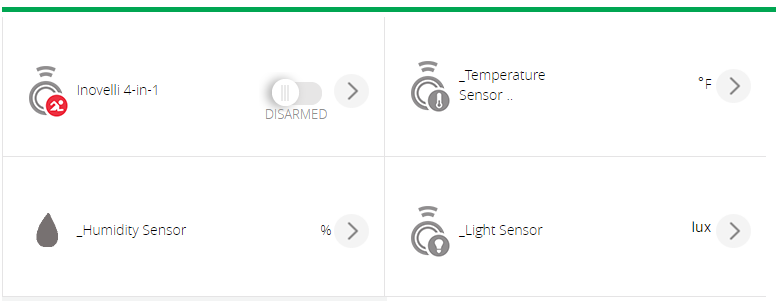
- Select the new Parent device (not the child sensors that start like _Temperature Sensor), then click on Advanced.
- Go to the Params tab and make the following changes:
- device_type: urn:schemas-micasaverde-com:device:MotionSensor:1
- device_file: D_MotionSensor1.xml
- device_json: D_MotionSensor1.json
- Give it a couple of minutes. Wait. Do not do anything – for like 5 minutes. Please…
- Reboot your Vera
- When it’s back online, press the configure button on the back of the Inovelli 4-in-1 three times quickly. Don’t do anything in the Vera hub – nothing.
- Wait for a period of time (I can’t tell you because I got distracted for 2 hours) and everything should show up working.
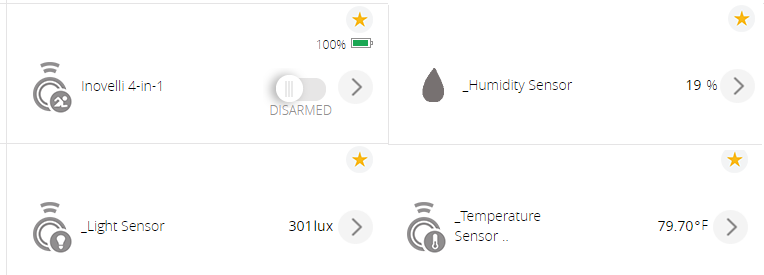
The key with Vera is patience.
Power Options 
I always prefer the CR123 batteries. I also like having the option for continuous power (micro USB) on my motion sensors. Motion sensors are an integral part of home automation and security, and leaving this critical function up to batteries is not always the best route. This sensor provides both, sort of. See the footnotes. I knocked a full point off for the lack of well thought out enclosure for the USB cable. Perhaps I expect more out of Inovelli. They usually have this stuff nailed and the DIY cover for the USB cable seemed like too much of an after thought.
| Power Type | Qty |
 CR123 Battery CR123 Battery |
1 |
 Micro USB Micro USB |
Yes 1 |
| No | |
| No | |
| Other | No |
- Although it does provide an option for a micro-USB power port, you need to bake your own with a 3D printer (like we all have those lying around). Your other option is to leave the back off, or figure out another way to rig something together.

Overall Performance
The Inovelli 4-in-1 Sensor performs very well in the compatible hubs. It is clear to see in the Hubitat tests what the sensor is capable of. As for the motion response time for Vera, it’s difficult to say if the problem lies on the hub or in the sensor. At any rate, it’s irrelevant since you have the hub you have and you need a sensor that performs well with that hub. Performance testing is measured as follows.
For clarity, I do not start the clock when the motion sensor indicator turns on, I start the clock when I initiate motion. I stop the clock (though video playback) as soon as the UI on the hub provides feedback that motion is detected.
These tests were all performed on unloaded (clean) hubs, meaning that there is really nothing happening on the hub itself. So the results are a pure as I can get them (in my very non-scientific way).
Motion Sensitivity was set to Maximum (10) for all tests.
| Hub | Minimum Response Time (seconds) | Average Response Time (seconds) | Max Response Time (seconds) | Missed Detections 1 |
| Hubitat | 0.37 | 0.75 | 1.51 | 0/20 |
| SmartThings | 0.89 | 1.23 | 3.46 | 0/20 |
| Wink Hub 2 | N/A | N/A | N/A | N/A |
| Vera 3 | 1.92 | 2.27 | 2.45 | 0/20 |
- Of the total number of speed tests, how many times did the sensor fail to detect the motion. For example, a ratio of 5/20 means that out of 20 times motion was active, how many times did the sensor fail to trigger a motion alert).
- See the hub specific notes in the Hub Compatibility section above. I was unable to pair this as a motion sensor, so there is no performance data available.
- I tried several times to get the Vera number lower. There’s literally only two things in the hub when testing the Inovelli 4-in-1, so pretty sure it’s not a bogged down hub. Not sure why it was so slow.
Vera Speed Test Example
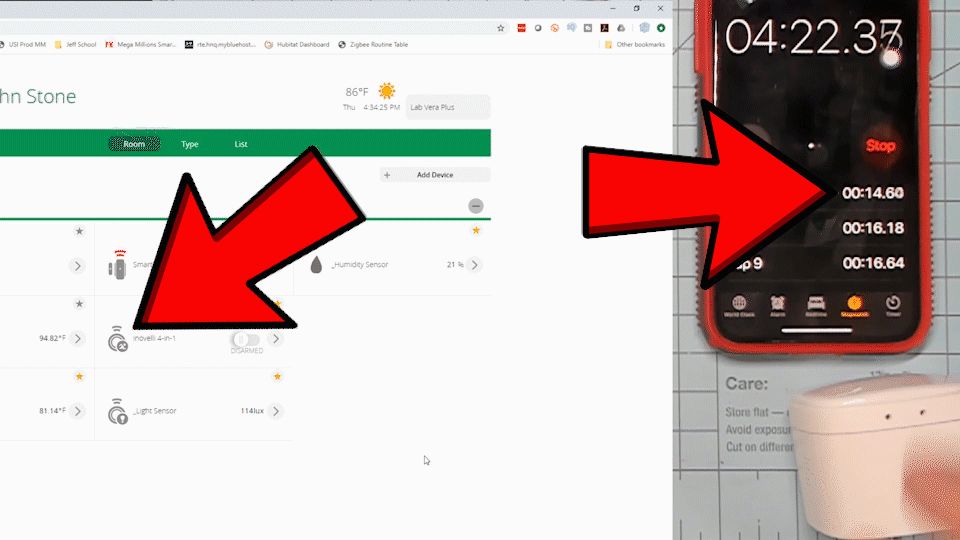
END

